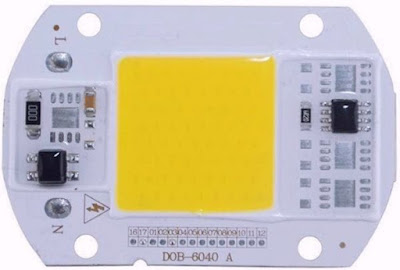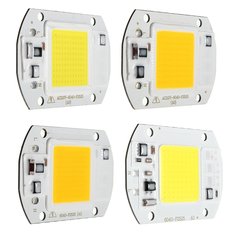
|
You connect them directly to the 230 V power line, they give a lot of light, hardly get hot and they are cheap. Use these remarkable LED arrays in inventive light design! |
Introduction to the DOB-6040A family
What does DOB mean?
DOB is the acronym for 'Driver On Board', which means that all the electronics needed to control the LEDs on the array are present. You can connect these DOB arrays directly to the mains voltage, the electronics take care of the control of the LEDs.
The DOB-6040A
Under the type number DOB-6040A you can buy LED arrays that cost a little more than three euros and that deliver a power of 20 W, 30 W or 50 W. The arrays are insulated and mounted on an aluminum carrier, which ensures good heat conduction and which makes it easy to mount the array on a cooling plate. In most cases this is not even necessary, because the array is protected against temperatures above 150°C. The arrays are available with LEDs that emit cold white or warm white light.
The picture below shows the 20 W type. You can see that there is only one chip on the left. If you buy the 30 W or 50 W version, the three empty places are filled with identical chips and there are more LED chips under the insulating silicone layer.
 |
| Physical characteristics of the DOB-6040A family of LED arrays. (© Banggood) |
The backside consists of a nice smooth aluminum plate that is isolated from the electronics and can therefore easily be screwed onto a metal surface. The four holes for the attachment are in a square at exactly 33.0 mm centre to centre distance. The aluminum plate itself has dimensions of 40 mm by 60 mm.
 |
| The backside consists of a smooth aluminum plate. (© 2018 Jos Verstraten) |
The LED chips are so small that you can hardly see them with the naked eye. In the 20 W version tested by us, the luminous part of the array consists of eight rows, each with nine LED chips. In the versions with more power, that number is greater. The light spectrum ranges from 380 nm to 840 nm, see the graph below.
 |
| The wavelength spectrum of the applied LED chips. (© Aliexpress) |
Of course we were curious about the electronics present on the array. After demolishing one of the arrays we could find out the type number of the applied chip: BP5132H. This is an IC of the Chinese Bright Power Semiconductor Co.

The figure below shows the internal block diagram of this chip. It is a constant current source, which sends a current determined by one external resistance through the chain of LED chips connected in series. The output stages are designed as high-voltage MOSFETs with a breakdown voltage of 500 V. The thermal protection switches on at a chip temperature of 150 °C. If the temperature rises, the IC will automatically reduce the LED current so that the dissipated power decreases.
 |
| The internal block diagram of and the standard circuit around the BP5132H. (© Bright Power Semiconductor Co) |
- Price indication: € 3.00
- Dimensions array: 60 mm x 40 m
- Dimensions LED panel: 24 mm x 24 mm
- Input voltage: 230 Vac
- Power: 20 W, 30 W, 50 W
- Light colour: cold white or warm white
- Radiated spectrum: 380 nm to 840 nm
- Brightness: 80 lm/w to 90 lm/w
- Light flux: 1,000 lm to 1,999 lm
- Beam angle: 180 degrees
The DOB-6040A in practice
The application of the DOB-6040A
There is in fact nothing interesting to write about the application of the DOB-6040A. You connect the mains voltage between the two solder islands L and N and the LEDs will be radiating. The 20 W version we tested consumes a mains current of 65 mA, which corresponds to a power consumption of 14.95 W.
 |
| Applying these LED arrays is a piece of cake. (© 2018 Jos Verstraten) |
When using the DOB-6040A, remember that the life-threatening 230 V mains voltage is present on the array and that you should always think carefully before doing anything.

Can you dim these arrays?
An important question! The answer is: yes and no. The arrays are dimmable, but because they consume little power not every dimmer is able to dim such a low load. We used a dimmer type FG02N from Kemo Electronic. With only a DOB-6040A as load, nothing happened when turning the dimmer, the LEDs remained on at full power. With the addition of a 60 W incandescent lamp as extra load, the DOB-6040A proved to dim excellently. When the lamp started to glow, the LED chips also started to emit light. From that moment on, the intensity could be adjusted smoothly with the potentiometer of the dimmer. From this you can deduce that any standard dimmer is useful if you connect a few of these arrays in parallel to the output of the dimmer.

20W 1800LM WarmWhite DIY LED-Chip
